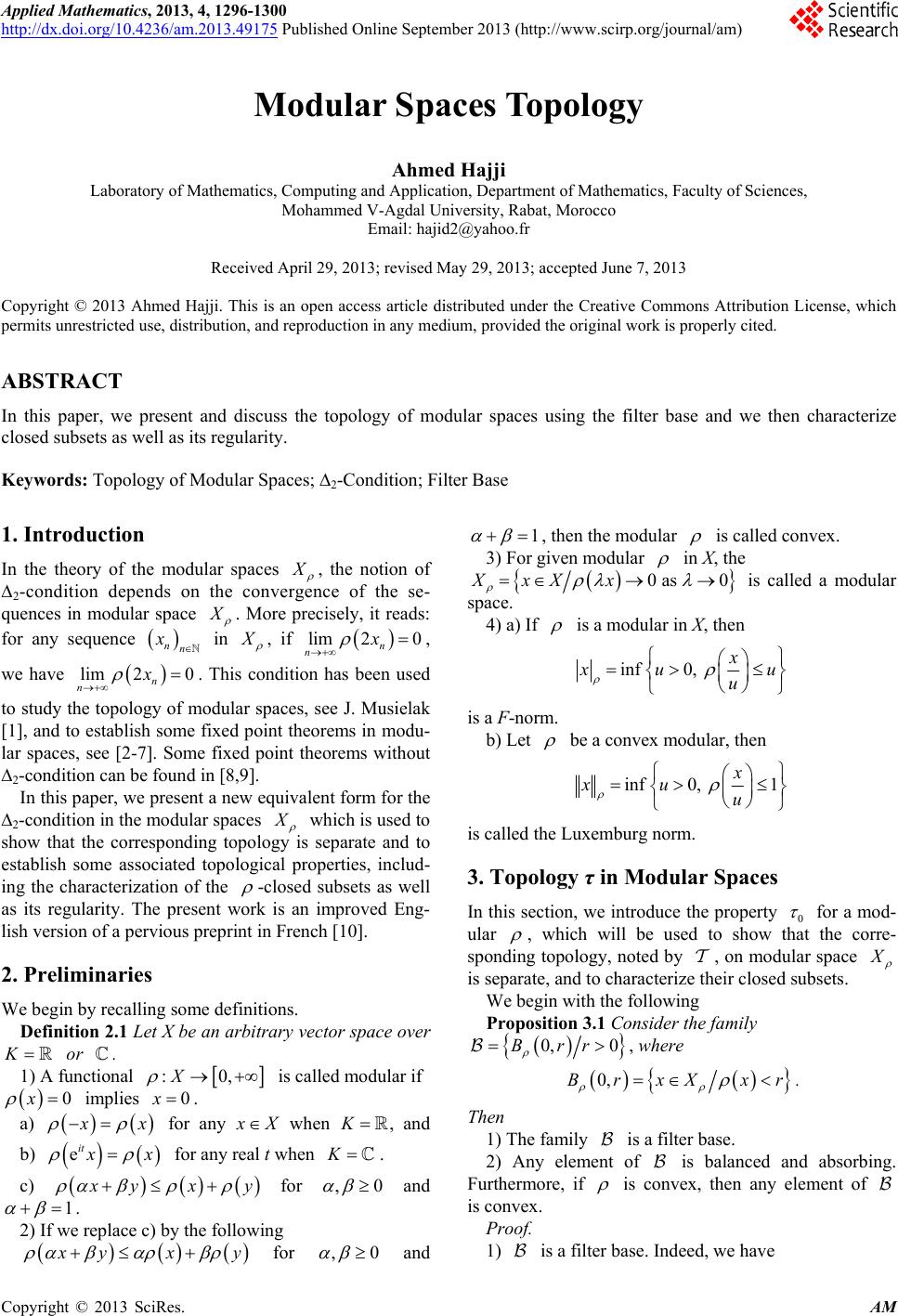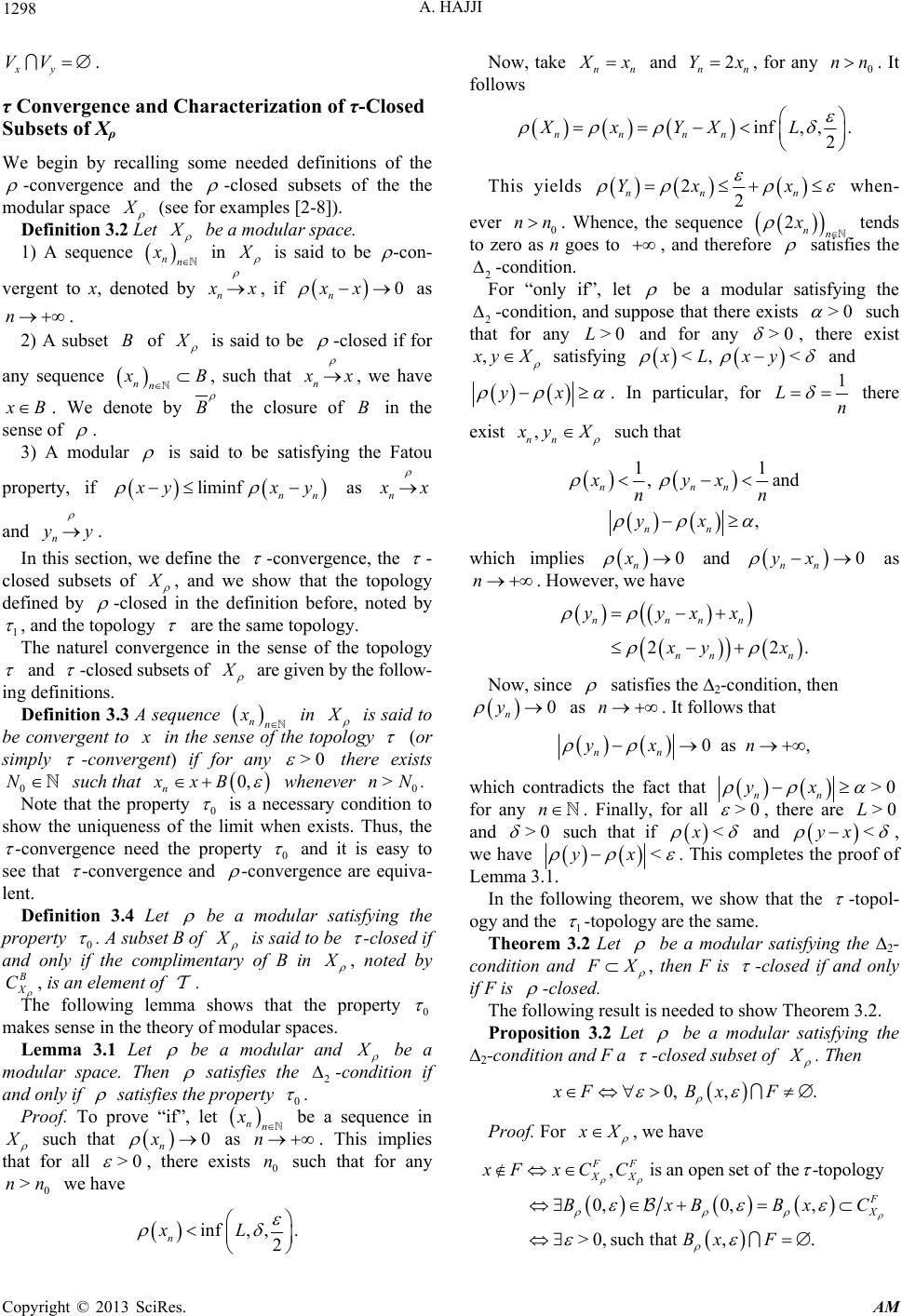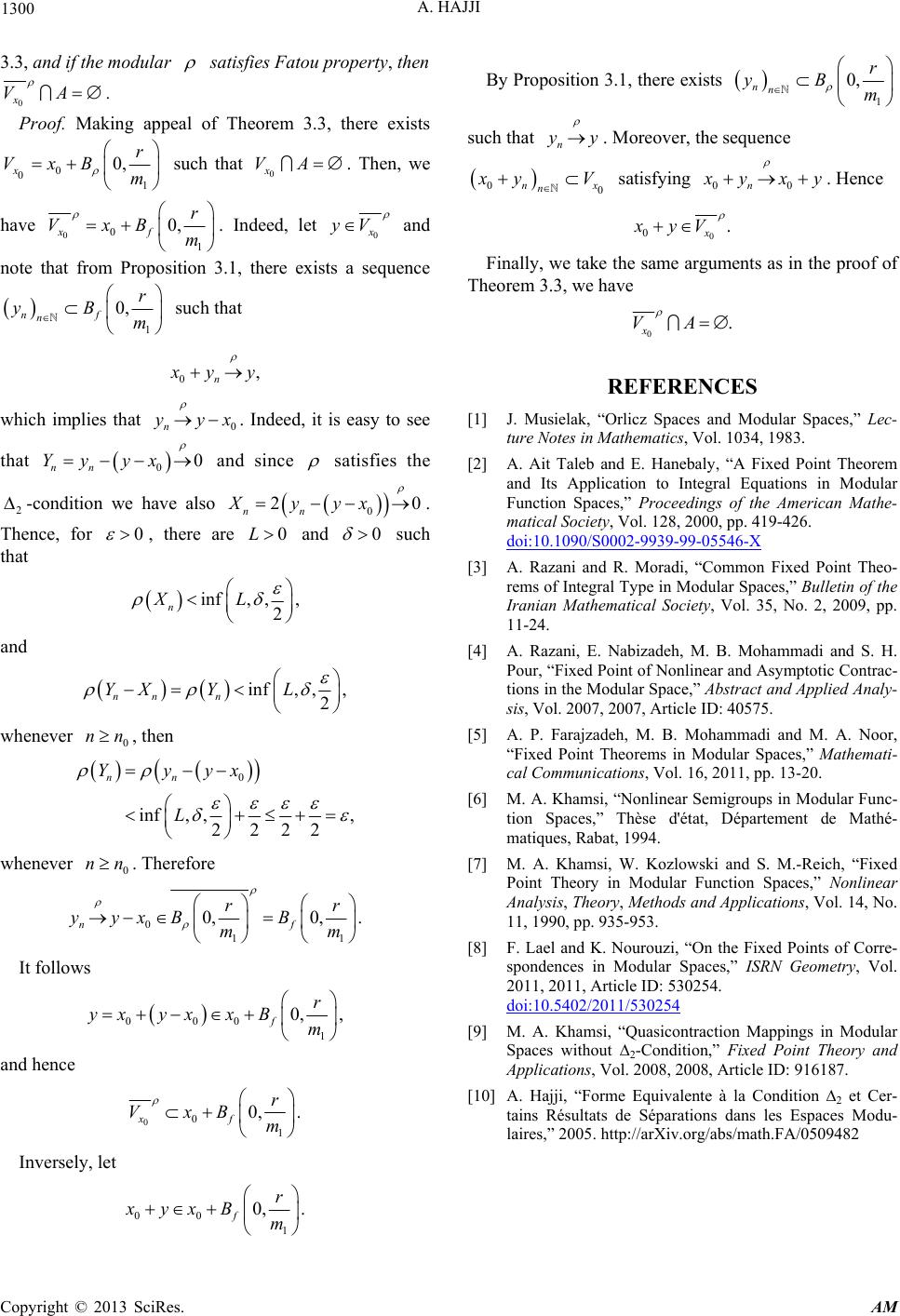 Applied Mathematics, 2013, 4, 1296-1300 http://dx.doi.org/10.4236/am.2013.49175 Published Online September 2013 (http://www.scirp.org/journal/am) Modular Spaces Topology Ahmed Hajji Laboratory of Mathematics, Computing and Application, Department of Mathematics, Faculty of Sciences, Mohammed V-Agdal University, Rabat, Morocco Email: hajid2@yahoo.fr Received April 29, 2013; revised May 29, 2013; accepted June 7, 2013 Copyright © 2013 Ahmed Hajji. This is an open access article distributed under the Creative Commons Attribution License, which permits unrestricted use, distribution, and reproduction in any medium, provided the original work is properly cited. ABSTRACT In this paper, we present and discuss the topology of modular spaces using the filter base and we then characterize closed subsets as well as its regularity. Keywords: Topology of Modular Spaces; ∆2-Condition; Filter Base 1. Introduction In the theory of the modular spaces , the notion of ∆2-condition depends on the convergence of the se- quences in modular space . More precisely, it reads: for any sequence nn x in , if m 20 n nx li , we have 0 n xlim 2 n . This condition has been used to study the topology of modular spaces, see J. Musielak [1], and to establish some fixed point theorems in modu- lar spaces, see [2-7]. Some fixed point theorems without ∆2-condition can be found in [8,9]. In this paper, we present a new equivalent form for the ∆2-condition in the modular spaces which is used to show that the corresponding topology is separate and to establish some associated topological properties, includ- ing the characterization of the -closed subsets as well as its regularity. The present work is an improved Eng- lish version of a pervious preprint in French [10]. 2. Preliminaries We begin by recalling some definitions. Definition 2.1 Let X be an arbitrary vector space over or . 1) A functional :0,X 0x is called modular if 0x implies . a) x for any X when , and b) eit x for any real t when . c) yx y0 for , and 1 . 2) If we replace c) by the following yx y0 for , and 1 , then the modular is called convex. 3) For given modular in X, the 0X x 0 as Xx is called a modular space. 4) a) If is a modular in X, then inf x 0, uu u is a F-norm. b) Let be a convex modular, then inf0, 1 x xu u is called the Luxemburg norm. 3. Topology τ in Modular Spaces In this section, we introduce the property 0 for a mod- ular , which will be used to show that the corre- sponding topology, noted by , on modular space is separate, and to characterize their closed subsets. We begin with the following Proposition 3.1 Consider the family 0Brr0, , where 0,BrxXxr . Then 1) The family is a filter base. 2) Any element of is balanced and absorbing. Furthermore, if is convex, then any element of is convex. Proof. 1) is a filter base. Indeed, we have C opyright © 2013 SciRes. AM  A. HAJJI 1297 a) because any 0,Br . b) Let and 1 0,Br 0,Br 2 zB be in and set . Then, for any we have 12 ,rrinfr 0, r 2 1 2 zrr zrr and therefore . That is 1 0, 0,zB rB r 12 0,0,0, .BrBrBr Hence is a filter base for the existence of 0,Br such that 12 0,0, 0,BrBrBr . 2) Let . 0,Br 0,Br a) is balanced. Indeed, for given ei with and 1 , and given 0, Br , we have e i< xxx r. This means that 0, Br . b) is absorbing. Indeed, for given 0,Br X we have . Whence, for all there 00x lim >0r exists >0, such that 0< < and < r . Hence, there exists >0 such that 0, Br . This shows that is absorbing. 0, rB Now, assume that is in addition convex and let . For given 0,Br ,0 , yB r and 0,1 , we have 11<, yx y r ,. then 10 yB r Thence is convex. 0,Br Definition 3.1 We say that satisfies the property 0 if for all >0 , there exist and >0L>0 such that yx for every x, y satisfying L and <xy . Theorem 3.1 Assume that the modular satisfies the property 0 . Then is a separate topological vector space. Proof. In Proposition 3.1, we have seen that the family is a filter base, and furthermore any element of is balanced and absorbing. On the other hand, for any , there exists 0,Br 0>0 such that 00 0,0,0, .BB B r In fact, let ; >>0r . Since satisfies the property 0 , there are and >0L>0 , such that for < L and <xy we have <yx . Thus, if we set 0inf, ,,rL we see that for 00 0, 0,zxyBB with 0 0. x y We obtain 0 0,yzxB . This implies zx 0 and 0 L . Thence 0.zx r r This infers that 0,zBr , and so 00 0, 0,0,BB B r. Hence the family is a fundamental system of neighborhoods of zero, then the unique topology defined by in is given by ,if , then such that , GGXxG VxVG so that is a topological vector space. To show that ,X is separate, let x, y in such that y and assume that for any Vx neighbor- hood of x and Vy neighborhood of y we have xy VV . So that one can consider 11 0, 0,zxByB nn for certain . Then * n 1 1. xz n yz n Since satisfies the property 0 , then there exist for any 0 , two reals and 0L0 , such that <2 yx for every x, y satisfying < L and <yx . Now, set and Yyx zx and note that we have 1 1. Xxz n YXyz n It follows that for any n such that 1inf,, 2 L n , we have . 222 Yyxzx This infers that yx , for arbitrary 0 . Thus, 0xy and then x = y, a contradiction since by hypothesis y . Therefore there exist neighbor- hoods V of x and neighborhood V of y such that Copyright © 2013 SciRes. AM  A. HAJJI 1298 xy VV. τ Convergence and Characterization of τ-Closed Subsets of Xρ We begin by recalling some needed definitions of the -convergence and the -closed subsets of the the modular space (see for examples [2-8]). Definition 3.2 Let be a modular space. 1) A sequence nn x in is said to be -con- vergent to x, denoted by n x , if as . 0 n xx n 2) A subset of B is said to be -closed if for any sequence nn B , such that n x , we have B. We denote by B the closure of in the sense of B . 3) A modular is said to be satisfying the Fatou property, if liminf nn yx y as n x and . n yy In this section, we define the -convergence, the - closed subsets of , and we show that the topology defined by -closed in the definition before, noted by 1 , and the topology are the same topology. The naturel convergence in the sense of the topology and -closed subsets of given by the follow- ing definitions. are Definition 3.3 A sequence nn x in is said to be convergent to in the sense of the topology (or simply -convergent) if for any >0 there exists such that 0 N 0,B n xx whenever . 0 Note that the property 0 >nN is a necessary condition to show the uniqueness of the limit when exists. Thus, the -convergence need the property 0 and it is easy to see that -convergence and -convergence are equiva- lent. Definition 3.4 Let be a modular satisfying the property 0 . A subset B of is said to be -losed if and only if the complimentary of B in c , noted by X C , is an element of . The following lemma shows that the property 0 makes sense in the theory of modular spaces. Lemma 3.1 Let be a modular and be a modular space. Then satisfies the -condition if and only if 2 satisfies the property 0 . Proof. To prove “if”, let nn x be a sequence in such that as . This implies that for all 0 n x >0 n , there exists such that for any we have 0 n 0 >nn inf, ,. 2 n xL Now, take nn x and , for any . It follows 2 n Yxn0 nn inf, ,. 2 nnnn XxYX L This yields 22 nn n Yx x when- ever 0. Whence, the sequence nn 2n x n tends to zero as n goes to , and therefore satisfies the 2 -condition. For “only if”, let be a modular satisfying the 2 -condition, and suppose that there exists >0 such that for any and for any >0L>0 , there exist , yX satisfying <,xL <xy and yx . In particular, for 1 Ln there exist , nn yX such that 11 , and , nnn nn xyx nn yx which implies 0 n x and as . However, we have 0 nn yx n 22 nnnn nn n yyxx . yx Now, since satisfies the ∆2-condition, then 0 n y as . It follows that n 0 as , nn yxn which contradicts the fact that >0 nn yx for any n . Finally, for all >0 , there are and >0L >0 such that if x< and yx < , we have <yx . This completes the proof of Lemma 3.1. In the following theorem, we show that the -topol- ogy and the 1 -topology are the same. Theorem 3.2 Let be a modular satisfying the ∆2- condition and X , then F is -closed if and only if F is -closed. The following result is needed to show Theorem 3.2. Proposition 3.2 Let be a modular satisfying the ∆2-condition and F a -closed subset of . Then 0, ,.xFBx F Proof. For X , we have ,is an open setofthe-topology 0,0, , >0, suchthat,. FF XX X xFxC C BxBBx BxF C Copyright © 2013 SciRes. AM  A. HAJJI 1299 Finally, >0, ,.xFBx F Proof of Theorem 3.2. Let be -closed and n be a sequence in n x such that n x . Then, for any >0 , there exists 0 such that for every , we have n 0 >nn , n Bx . This implies that >0, ,.BxF Whence, making use of Proposition 3.1, we get that F. Conversely, assume that is not -closed, then X C is not an open set for the -topology. There exists then X C satisfying , X CBx and so ,Bx F for any >0 . Therefore, for 1 k there exists 1 , k Bx k F nn . Thence, the obtained sequence F satisfies n x . This implies F, which is in contradiction with the fact that X C . In conclusion, F is -closed. Remark 3.1 Observe that 2 0 satisfiesthe-condition satisfies the property. As consequence, we see that under the assumption that satisfies the 0 property, we have 1topology topology. Then definitions of -convergence and -closed subsets of need the hypothesis that satisfies the ∆2-condition. The following result shows that the modular space is a regular space. Theorem 3.3 Let be a modular satisfying the ∆2- condition, A be a -closed subset of and 0 A . Then there exists an open neighborhood 0 V of 0 such that . 0 x In order to show the theorem above, we need the following result. VA Proposition 3.3 Let be a modular satisfying the ∆2-condition and X . Then ,inf ,xAx y yA 0 if and only if A , where is the closure of A for the -topology. Proof. We have ,inf ,xAx y yA 0. Then for any 1 n , there exists such that n yA 1 < n xy n this implies that there exists a sequence nn y Ax such that . Whence n y A . Inversely, let A , then by Theorem 3.2, there ex- ists a sequence nn y A such that , there- n y x fore, for any 0 there exists such that 0 n n0 ,;. Axy n n Hence xA,0 . Proof of the Theorem 3.3. By Proposition 3.3, 0 A if and only if 0 xA ,>r0 . Next, since satisfies the 2 -condition then by Lemma 3.1, for >0 3 r, there exist , and 0L0 such that if L and yx we have yx . More- over, there exists such that * 0 m inf , rL m whenever 0. Now, let and we consider the open neighborhood of mm 1 max 3,m 0 0 m 0 0 1 0, . xr VxB m Suppose next that 0 and let 0 x VAx VA. Since is closed we make use of Proposition 3.1 to exhibit a sequence nn y Ay such that . So n y that one considers nn yy and . Since 0n Yxy n n yA and 0 A , then . On the other hand, note that n Yr 1 inf, , nn r Xyy L m whenever and 0 nn 0 1 inf, . nn r XY xyL m Therefore 1 2 33 nn rr r rY yym whenever , a contradiction. Thus 0 nn0 x VA . Remark 3.2 If satisfies Fa tou p roperty, then 0,Br 0,B rxXxr is a closed ball of the topology . We note by , f Bxr 0r all closed ball centered at x with the radius (see [7]). Corolla ry 3.1 Under th e same hypotheses of Theorem Copyright © 2013 SciRes. AM  A. HAJJI Copyright © 2013 SciRes. AM 1300 3.3, and if the modular satisfies Fatou property, then By Proposition 3.1, there exists 1 0, nn r yB m such that . Moreover, the sequence n y 0 x VA . Proof. Making appeal of Theorem 3.3, there exists y 00 n n 0 0 1 0, xr VxBm such that . Then, we have 0 x VA 00 1 0, xf r VxB m x y V satisfying 00n yx y. Hence . Indeed, let 0 x yV and note that from Proposition 3.1, there exists a sequence 1 0, nf n r yB m 0 0. x xyV Finally, we take the same arguments as in the proof of Theorem 3.3, we have such that 0. x VA 0, n yy REFERENCES which implies that . Indeed, it is easy to see that and since 0n yyx 00x nn Yy y satisfies the -condition we have also . 2 0 2Xyyx [1] J. Musielak, “Orlicz Spaces and Modular Spaces,” Lec- ture Notes in Mathematics, Vol. 1034, 1983. 0 nn [2] A. Ait Taleb and E. Hanebaly, “A Fixed Point Theorem and Its Application to Integral Equations in Modular Function Spaces,” Proceedings of the American Mathe- matical Society, Vol. 128, 2000, pp. 419-426. doi:10.1090/S0002-9939-99-05546-X Thence, for 0 , there are and 0L0 such that [3] A. Razani and R. Moradi, “Common Fixed Point Theo- rems of Integral Type in Modular Spaces,” Bulletin of the Iranian Mathematical Society, Vol. 35, No. 2, 2009, pp. 11-24. inf, ,, 2 n XL and [4] A. Razani, E. Nabizadeh, M. B. Mohammadi and S. H. Pour, “Fixed Point of Nonlinear and Asymptotic Contrac- tions in the Modular Space,” Abstract and Applied Analy- sis, Vol. 2007, 2007, Article ID: 40575. inf, ,, 2 nnn YX YL whenever , then 0 nn[5] A. P. Farajzadeh, M. B. Mohammadi and M. A. Noor, “Fixed Point Theorems in Modular Spaces,” Mathemati- cal Communications, Vol. 16, 2011, pp. 13-20. 0 inf, ,, 2222 nn Yyyx L [6] M. A. Khamsi, “Nonlinear Semigroups in Modular Func- tion Spaces,” Thèse d'état, Département de Mathé- matiques, Rabat, 1994. whenever . Therefore 0 nn 0 11 0,0,. nf rr yyxB B mm [7] M. A. Khamsi, W. Kozlowski and S. M.-Reich, “Fixed Point Theory in Modular Function Spaces,” Nonlinear Analysis, Theory, Methods and Applications, Vol. 14, No. 11, 1990, pp. 935-953. [8] F. Lael and K. Nourouzi, “On the Fixed Points of Corre- spondences in Modular Spaces,” ISRN Geometry, Vol. 2011, 2011, Article ID: 530254. doi:10.5402/2011/530254 It follows 000 1 0, , fr yxyxx Bm [9] M. A. Khamsi, “Quasicontraction Mappings in Modular Spaces without ∆2-Condition,” Fixed Point Theory and Applications, Vol. 2008, 2008, Article ID: 916187. and hence [10] A. Hajji, “Forme Equivalente à la Condition ∆2 et Cer- tains Résultats de Séparations dans les Espaces Modu- laires,” 2005. http://arXiv.org/abs/math.FA/0509482 00 1 0,. xf r VxB m Inversely, let 00 1 0, . fr xyxB m
|